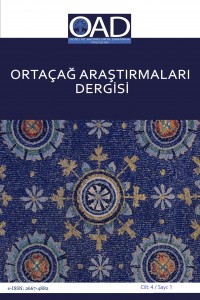Abstract
Anadolu 11. Yüzyılın ikinci yarısında Bizans ve Selçuklu ordularının savaş yeri haline gelmiştir. Jean Claude Cheynet'in "La perte de l' Asie Mineure au XIe siècle: A-t-elle laissé des traces dans l' anthroponymie familiale?”" (11. Yüzyılda Anadolu'nun Kaybı Aile Antroponimisinde İzler Bıraktı Mı?) adlı çalışmasında Malazgirt Savaşı (1071) öncesinde başlayan ve savaştan sonra Türk tehlikesi nedeniyle yoğunlaşan Bizans aristokrasinin batıya göçleri ve bu göçlerin soy isimlerine bakılarak mühürler ile antroponimde nasıl yansıdığı ele alınmaktadır.
Keywords
Abstract
Anatolia became a battleground between Byzantine and Seljuk armies in the second half of the 11th century. Jean Claude Cheynet's work, titled "La perte de l 'Asie Mineure au XIe siècle: A-t-elle laissé des traces dans l'anthroponymie familiale?" (Did the Loss of Anatolia in the 11th Century Leave a Trace in Family Names?), examines the migration of the Byzantine aristocracy to the west, which started before the Battle of Malazgirt (1071) and increased after the battle due to the Turkish danger, and how these migrations shaped the anthroponymy on seals by looking at the noble family names, titles and administrative positions.
Keywords
Details
| Primary Language | Turkish |
|---|---|
| Journal Section | Translate Article |
| Translators | |
| Publication Date | June 26, 2021 |
| Submission Date | November 10, 2020 |
| Published in Issue | Year 2021 Volume: 4 Issue: 1 |
Cite
Articles published in Ortaçağ Araştırmaları Dergisi are licensed under a Creative Commons Attribution-NonCommercial 4.0 International License (CC BY-NC 4.0). Ortaçağ Araştırmaları Dergisi provides immediate open-access to its content, reflecting its conviction in advancing global knowledge exchange. The opinions presented in the articles are the sole responsibility of their respective authors and do not present the view or opinions of Ortaçağ Araştırmaları Dergisi. Terms of Use & Privacy Policy





